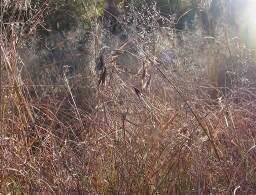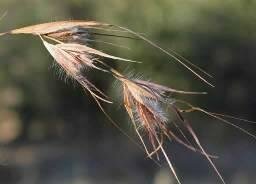 |
 |
|


Not all grass is green ...
Grass
 |
|
 |
|
Don’t just hike, admire and feel the great variety of grasses in the Magaliesberg. Once on the escarpment look in awe at the patchwork farmers fields, and give a thought to …
Think as you press beneath your feet
The frost-graced grass’s yellowed leaves,
That grass makes flesh, and flesh is meat,
Or else for bread is bound in sheaves.
This staff of life, this stem of grass,
Obsequious to the hiker’s stride.
Will gainsay none who wish to pass –
Yet all our fortunes there abide.
Since you are largely what you eat,
And what you eat is largely grass,
Then, hiker, crushed beneath your feet
Is mankind’s future – gently pass!
All the world’s basic foodstuffs are grasses – maize, millet, rice, wheat, oats, barley, rye. Why? Because the seed of grasses contains unusually high amounts of endosperm – a nutritious material that animals find as valuable as does the grass embryo itself, for whom it is, of course, intended. Add to direct consumption in the form of bread, samp, flour etc., our indirect consumption of grass (e.g. flesh of herbivores) and as much as 90% of our diet is grass or grass derived.
It is worrying that so much of the world’s food needs depend on so few species of grass (in fact, overall, 90% of the human race’s nutrition comes from a mere 20 species), for such a narrow genetic base makes agriculture susceptible to the rapid spread of a disease or disorder over vast areas.
Yet grasses are so ubiquitous we perhaps give them less consideration than we ought.
Grasses occur from the tropics to the poles, from the sea shore to the tops of mountains. The most widespread of all flowering plants is a grass (the reed, Phragmites). Worldwide, there are about 9700 species, of these 967 (10%) occur in southern Africa. A third of these are endemic to the region, i.e. they grow nowhere else in the world. Most of the ‘good’ grazing grasses of the world originate from our region. Over 30% of the world’s land surface is covered by natural grassland or savannah dominated by grasses. In South Africa the figure is 87,6% under grassy vegetation of some sort.
What is it about grasses that make them so abundant and widespread?
Grasses evolved with great rapidity about 160m years ago. Why then, particularly? This explosion of grassy species more or less coincided with the break-up of the forested Gondwanaland super-continent. This change, from a single land mass and a single water body to a mosaic of earth and ocean, provoked global climate change. Climate became less uniform, more patchy and changeable. In this way, dry periods developed and along with them, for the first time, forest fires. These fires destroyed the tree cover over large areas, because trees – along with most other plant forms – grow from the tips of their branches (‘buds’) and these are the parts most easily damaged by fire in plants that have not adapted to it.
Grasses, which up to then had eked out a marginal existence, found themselves summoned to centre stage at this point for one simple reason: they grow from the base – the part most easily protected from fire. Thus they were able to expand into the habitat gaps left by the damaged and retreating forests.
As well as being a useful way of escaping the effects of all but the hottest fires, growing from the base means you can afford (within reason) to lose your top hamper – to grazing animals for instance – without being killed off. The leaf tip may be bitten off, but growth continues to push upwards from the bottom end. That’s why you can mow your lawn without killing your grass. In fertile soil, a grass can lose 80% of its above-ground growth to grazers and still survive.
Thus grass can cope with being burnt and eaten – a trick that ‘tip growers’ are not so good at.
The growth area at the base of each grass stem is programmed to produce just so many leaves, followed by one flower head. After it reaches this total, it dies. Before this, however, it will have produced some daughter stems around its base. A tuft of grass grows outwards in this manner, rather like a fungal ‘fairy ring’ with living stems around the periphery, dead ones in the centre. That ill-considered tuft of grass over there may, in fact be several hundred years old.
Just think: without that little cluster of growth cells at the base of each stem of grass, civilization as we know it would never have existed.

 |
 |




